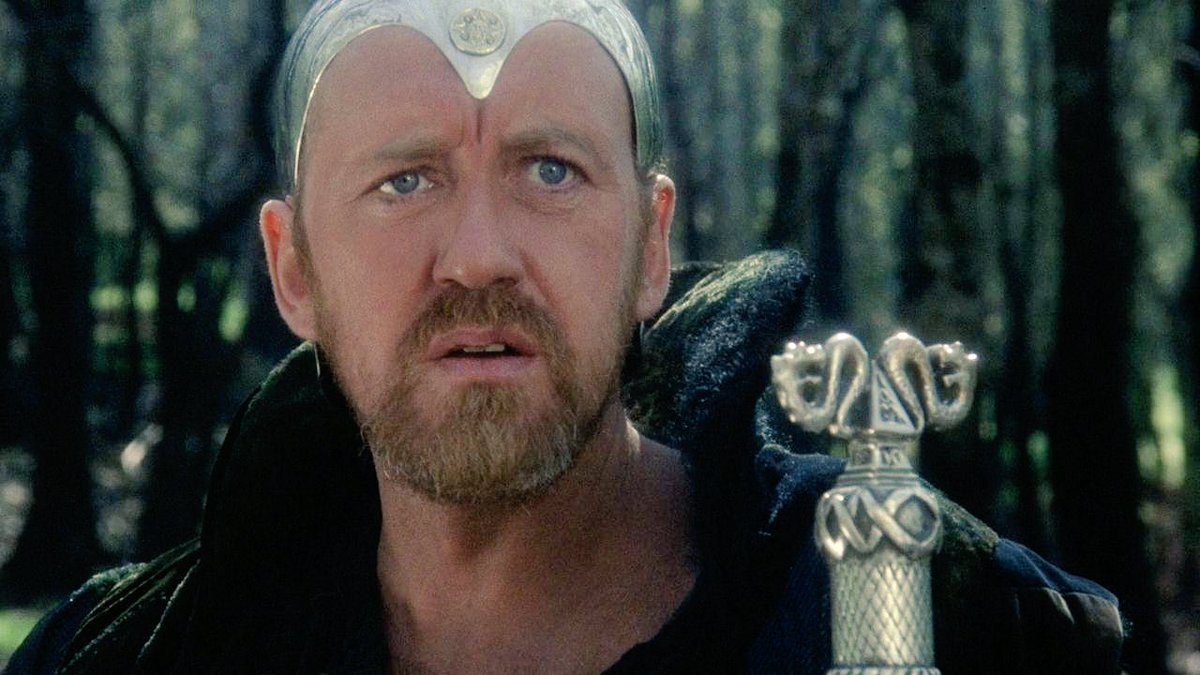Two light points to begin with:
1) Happy, dancing matrons in blockish medieval headdresses is by no means a bad look.
2) Congratulations to Nicol Williamson for playing the mighty wizard Merlin 'Chromebonce'.

But more particularly, every scene is full of men wearing armour. Knights are almost perpetually in armour. Armour uncovered by tabards or paint or engraving. Obviously metal armour. It becomes almost part of their being. The knight is not determined by their weapon (other than Excalibur, everyone is quite happy to switch weapons every so often) or their personal heraldry (rarely in evidence, aside from flags - never focused on, really).
Before the coming of Arthur, this is crude, black iron armour, with conspicuous spikes or studs. There are prominent straps and jangling discs. Heavy masks cover the face. Pauldrons are weighty and asymmetric. Modred's rebels share this armour. There is something Orc-like in it, though this may be a Peter Jackson-inspired retrospective thought. At any rate, the message is clear: until Arthur comes, we are all orcs - and it is worth remembering that the knights of Camelot are the raiders and reavers that rode with Uther, or their sons.
At Camelot, however, armour is shinier, sleeker and symmetric. Better proportioned, cleaner. The effect is striking and doubtless intentional. When knights wearing the two different types of armour fight, it is as if a Space Marine of the 41st Millennium is fighting Captain America: the clear, colourful, human and heroic against the hulking, industrial and deliberately ugly. Or, indeed, like watching Darth Vader fight Luke Skywalker.
Modred himself, of course, wears gold armour with spiked edges, a sculpted breastplate and a helmet shaped like a human face. An imperial, trying-too-hard parody of a knight, perhaps. I suspect that this was in a different way what the costume designers were going for with Snoke in The Last Jedi, with his gold robe, bright throne room and elaborately armoured guards; no dull, vast machinery and black hood for him. A pity the look was not maintained for other antagonists.
The look of these armours is so uniform to imply a degree of unreality - could any set of armour be so perfectly in keeping with its peers? But that's no real problem in this film.
***
One of the odder little details of the film are the pseudo-Nature worship angle of Merlin and Morgan Le Fay's magic. It's rather a step away from the tomes-and-alchemy Merlin of The Once and Future King, for instance. But it isn't (quite) the Celtic pagan remnant associated with Marion Zimmer Bradley (though interestingly, there is a constant 'Celtic Christianity'* feel to the Christianity of the film - beards, strange tonsures, gestures of blessing with oak branches).
Instead, we get strange paens to the possibly amoral force of the land called the Dragon. Difficult to summon up, unconcerned much with individuals and if not omnipresent, then certainly extensive in its presence. If it has a morality, the big-picture political concerns of Merlin and the health of the land are the closest thing it has.
The Prophet class of The 52 Pages might form an agreeable fit for a Merlin-esque character, or 'Prophet of the Great Dragon'.
Spell Schools: Knowledge, Nature, Illusion
Motto: Unite the Land and Make it Healthy
Symbol: Coiling serpent
Weapon: Staff, Metal Skullcap
*Not that we really have a solid idea of what that looked like, hence the scare quotes.
No comments:
Post a Comment